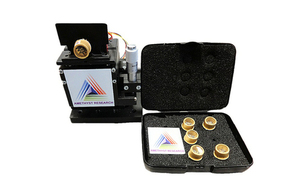Detecting explosives and chemicals with infrared technology
The Defence Science and Technology Laboratory (Dstl) is collaborating with industry and academia to develop an infrared detector capability.

An infrared detector [Picture: Amethyst Research (UK)]
Amethyst Research (UK), a small company based in Glasgow, was successfully funded under a call for proposals by Dstl’s Centre for Defence Enterprise, which funds research into novel, high-risk, high-potential-benefit innovations.
Dstl then introduced Amethyst to Selex ES, a Finmeccanica company and manufacturer of high performance thermal imagers.
The companies developed a plan to exploit Amethyst’s proprietary detector technology and Selex’s expertise in camera read-out circuitry so they could effectively compare and benchmark the emerging technology against current state-of-the-art technology.
Within 4 months, the programme demonstrated significant advantages over current products, and a credible supply chain for its manufacture and distribution was established within the UK.
Amethyst is now partnering with Lancaster University, CST in Scotland and IQE in Wales to consider how to take the novel detector technology to the next level of refinement and production, with a view to commercial exploitation that will support defence requirements.
Dstl fellow Ken McEwan said:
This project is an excellent case study in harnessing technology across a range of organisations for the UK’s commercial and economic benefit.
Dstl has acted as co-ordinator and expert adviser to assist Amethyst in taking its proprietary technology through various stages towards commercial exploitation.
As other international parties move into this space, the work performed in collaboration with Amethyst will protect the UK’s leading capability in infrared electro-optic sensors and systems.
Amethyst’s Chief Executive Officer, Terry Golding, said:
This programme has been vital to allowing us to effectively develop this platform technology, establish key partnerships and stress test the UK supply chain.
Dstl has been extremely agile and strategic to work with. This has allowed us to move quickly and position ourselves optimally for commercial development of this vitally important technology.
The Centre for Defence Enterprise (CDE) is currently running another competition for funding on the theme of novel electro-optic and infrared technology.
Up to £600,000 is available for proof-of-concept research projects. Bids must be submitted via the CDE online portal by 5:00pm on Thursday 8 May 2014.
For further information see the defence science and technology website.